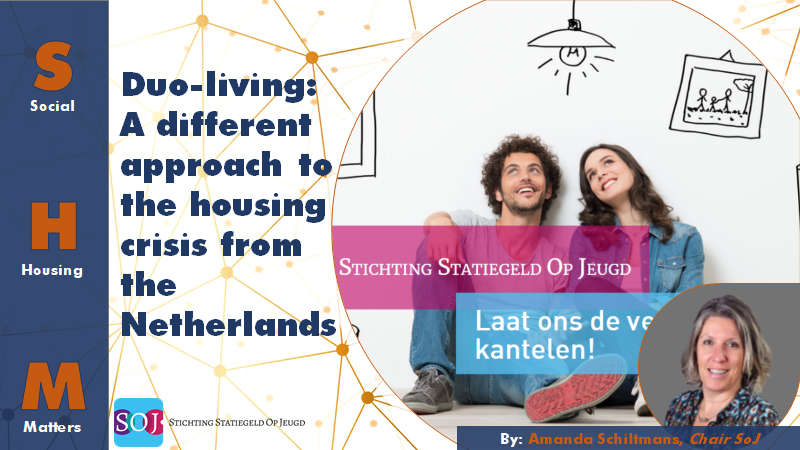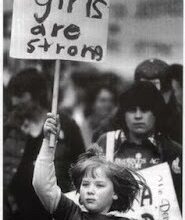By: Amanda Schiltmans, Stichting Statiegeld op Jeugd

Stichting Statiegeld op Jeugd (literally translated as ‘Deposit on Youth Foundation’), is committed to promote and get housing providers to offer a new form of housing; DUO-LIVING.
‘Duo-living’ is a housing ‘format’ where seniors can live independently for longer in their own homes, while young adults and those who, for example, are in need of a new home because of a change in family circumstances, such as divorce, have access to affordable rental homes in areas that are currently don’t have an accessible (social) rental market.
Facts – an ageing population and a housing crisis
We know that the aging population will increase enormously within the next ten years. We also know that housing requirements are also changing. Seniors want to live independently for as long as possible in complete privacy and in the environment that they are familiar with.
However, as you get older, some tasks become more difficult or are no longer possible and help nearby is desirable. You often see that seniors receive help from family members, but also find it very difficult to ask for this help because they realize that it puts a heavy burden on these people.
In addition to people who might already struggle with living independently, what we also see is that empty-nester often live in their own houses or rental homes, where various rooms and attic spaces are no longer in use because the children left the house.
We also regularly see that seniors have already placed their bedroom and bathroom on the ground floor and that they no longer visit the first floor and attic. This means that many square meters of valuable living space are unused and are essentially going to waste. These lost square metres could be given a sensible re-use!
Solution – it’s time to think differently about housing
Turning the surplus space into an independent living unit of +/- 50 m2 gives the empty bedrooms and attic spaces a new purpose.
The new living unit has its own entrance, bedroom, bathroom and living room with kitchen. The residential unit has its own house number and is officially classed as an independent living unit with the Land Registry. This is a requirement for the Dutch government if both parties would want to claim social facilities without consequences for each other.
In addition, the government is increasingly retreating when it comes to social support, which means that people can claim less and less and have to take more care for themselves.
When the care tasks are provided by care professionals and ensures that informal care tasks can be performed by the concerned neighbour, positive social cohesion is created and people who do not have a social safety net can still live independently. Societies are created with a healthy mix between young and old people and this contributes to vital living environments.
Duo-living is therefore a housing format that creates vital communities. In this way, local authorities and housing providers become ‘sustainable in people‘.
The sustainability comes from and is safeguarded by the ‘social contract’ that the people involved enter with the Foundation as a mediator between all parties involved.
In this contract, the new tenants agree to function as a helping hand for the seniors, by taking on or helping with things such as garden maintenance, window cleaning, shopping, but also things like having a social chat, helping them out with the computer, etc. The reward for entering this social contract is that the rent is very low.
This is being done so that it could help people save up for other things, whether that’s traveling or buying their own house. If they choose the latter, young people also have the opportunity one day to hopefully pay what they have profited from forward.
Preparing for a more sustainable Future: Duo-living
We have been living the way we do now for more than 100 years now. This is a way that is no longer desirable and sustainable in the current population make-up and its trajectory. This is why we have to look for new innovative solutions for various reasons. We see that there are three types of seniors who are open to this form of living:
- Seniors who indicate that their retirement provision is in the bricks (their own home) and they would like to have their money with them.
- Seniors who indicate that they do not really need the money, but that the maintenance, the loneliness, and their feeling of safety is gone.
- Seniors who indicate that they are now on a low monthly payment because the house has been paid off or they have a small mortgage and if they go to a rental home, they have to pay more than € 800.00 to € 1,100.00 per month for a senior apartment or house and they do not have or want to pay this amount of money. They want to use the money for nice older days and sometimes they need this money to purchase care.
That is why we want to challenge housing to think outside the box! That is why now is not only the time to look differently at the square metres of valuable living space that are going to waste and repurpose the current housing stock into dual purpose and make-up: combine (socially) rented and owned properties. It is also the time to look at the social cohesion between young and older people in new constructions in order to be ready for the future which holds an ageing population. Therefore….we’d like you to consider having a look at Duo-living.
About this article
This article was written by Amanda Schiltmans, director of SoJ.
If you have any questions or want to know more, please get in touch with her via info@st-soj.nl!
This article was first published in .Digital Bark magazine #3, published by DtL Creative in November 2020.
.Digital Bark is a magazine that shares the newest ideas, innovation and technology in housing in a way that speaks to all kinds of audience, whether you’re an IT expert or not! Have a look here!





One thought on “Duo-living: A different approach to the housing crisis from the Netherlands”